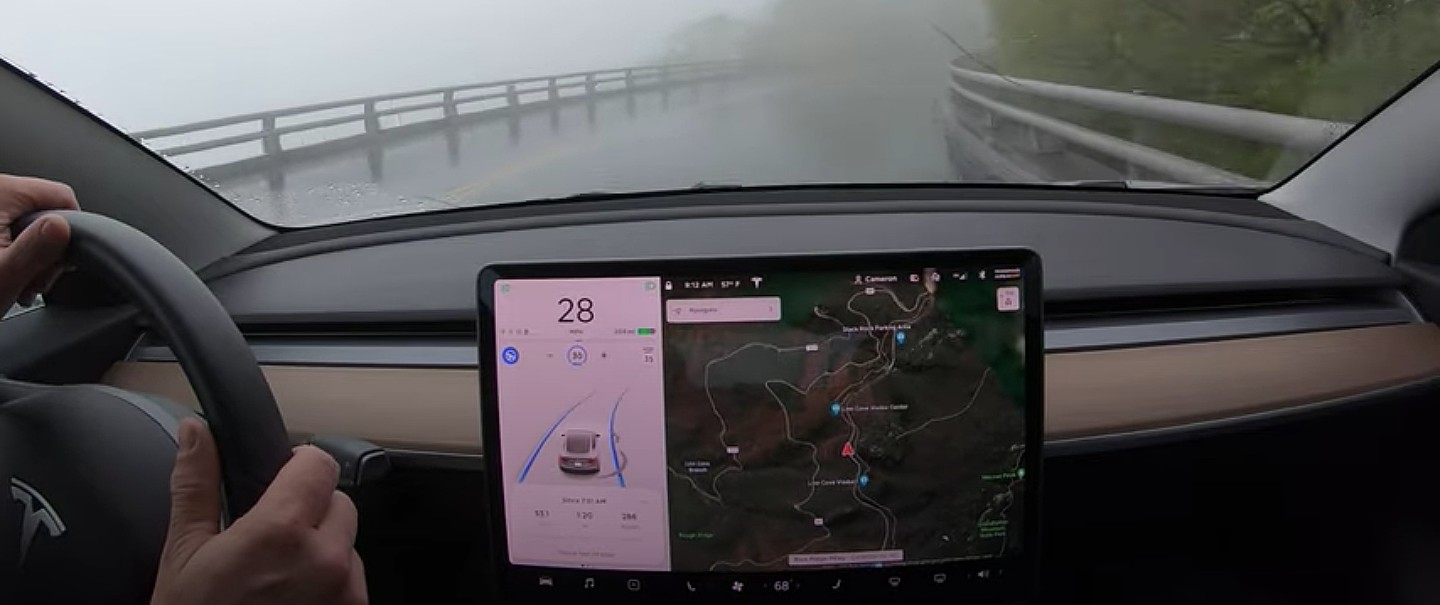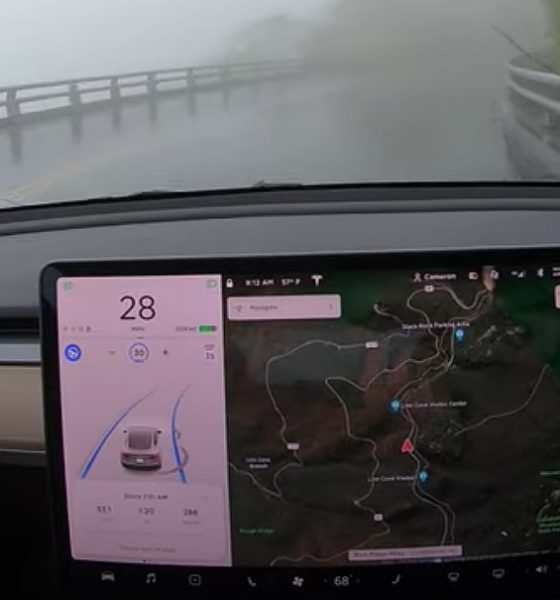

News
Tesla Autopilot impresses in 79-minute ‘Torture Test’ through long winding roads
A Tesla Model 3 owner recently tested Autopilot’s abilities on the long and winding roads of the Blue Ridge Parkway in North Carolina. The 45.9-mile trip lasted 79 minutes, giving the driver a fair amount of insight regarding Autopilot’s performance with update 2020.16.2.1.
In a later comment on Reddit, the host of Youtube’s The Tech of Tech channel stated that he decided to test Autopilot’s capabilities on rainy, foggy roads stretching across the historic Blue Ridge Parkway in North Carolina.
“I did adjust the maximum speed to accommodate visibility due to fog as Autopilot doesn’t know to just slow down- it will shut off if it can’t see far enough for the speed. However, by lowering the maximum speed to what I’d want to drive anyway, Autopilot remains engaged. Other than that, all steering, braking, acceleration, etc. is done by the car and not me,” the driver wrote.
One notable feature of the update focused on Autopilot’s capability to slow down for sharp curves, which results in safer navigation through abrupt turns. For example, on a right turn, the car will drive closer to the right edge of the pavement, which provides a safer environment if two vehicles are driving through the same curve in opposite directions.
Tech of Tech indicates that the addition of the “Slowing for Sharp Curves” feature was the only reason the car could navigate the tricky roads of the Blue Ridge Parkway, which it did in impressive fashion.
Tesla rolled out a similar feature last year, but there were some issues with its performance that made some drivers feel uncomfortable. The company continually improved the capability, which was then released with 2020.16.2.1 to owners around May 16 this year, according to TeslaFi.com.
“This update introduced new slowing behavior. Autopilot slows much more for tight curves than before, and it does so much more smoothly than the aborted slowing behavior introduced when V10 first released,” the host said.
As could be seen in the video of the torture test, Autopilot managed to navigate through the various challenging sections of the Blue Ridge Parkway for 79 straight minutes before the car took a turn a bit too sharply, which required the driver to intervene. This instance was the only mistake that the car’s software made in almost 46 miles of driving, and that’s in questionable weather conditions and on a stretch of road that challenges even human drivers.
Tesla’s Autopilot software continues to improve through the millions of miles of driving data that owners contribute to the company’s Neural Network. Tesla CEO Elon Musk indicated during the company’s Q1 2020 Earnings Call that the Neural Net’s training was coming along nicely and that contributions were being assessed to improve the safety and performance of the company’s driver-assist features.
“We are collecting data from over 1 million intersections every month at this point. This number will grow exponentially as more people get the update, and as more people start driving again. Soon, we will be collecting data from over 1 billion intersections per month. All of those confirmations are training on neural net, essentially, the driver when driving and taking action is effectively labeling — the labeling reality as they drive, and making the neural net better and better,” Musk said.
Watch The Tech of Tech‘s Tesla Model 3 navigate the Blue Ridge Parkway below.

News
Tesla FSD fleet is nearing 7 billion total miles, including 2.5 billion city miles
As can be seen on Tesla’s official FSD webpage, vehicles equipped with the system have now navigated over 6.99 billion miles.

Tesla’s Full Self-Driving (Supervised) fleet is closing in on almost 7 billion total miles driven, as per data posted by the company on its official FSD webpage.
These figures hint at the massive scale of data fueling Tesla’s rapid FSD improvements, which have been quite notable as of late.
FSD mileage milestones
As can be seen on Tesla’s official FSD webpage, vehicles equipped with the system have now navigated over 6.99 billion miles. Tesla owner and avid FSD tester Whole Mars Catalog also shared a screenshot indicating that from the nearly 7 billion miles traveled by the FSD fleet, more than 2.5 billion miles were driven inside cities.
City miles are particularly valuable for complex urban scenarios like unprotected turns, pedestrian interactions, and traffic lights. This is also the difference-maker for FSD, as only complex solutions, such as Waymo’s self-driving taxis, operate similarly on inner-city streets. And even then, incidents such as the San Francisco blackouts have proven challenging for sensor-rich vehicles like Waymos.
Tesla’s data edge
Tesla has a number of advantages in the autonomous vehicle sector, one of which is the size of its fleet and the number of vehicles training FSD on real-world roads. Tesla’s nearly 7 billion FSD miles then allow the company to roll out updates that make its vehicles behave like they are being driven by experienced drivers, even if they are operating on their own.
So notable are Tesla’s improvements to FSD that NVIDIA Director of Robotics Jim Fan, after experiencing FSD v14, noted that the system is the first AI that passes what he described as a “Physical Turing Test.”
“Despite knowing exactly how robot learning works, I still find it magical watching the steering wheel turn by itself. First it feels surreal, next it becomes routine. Then, like the smartphone, taking it away actively hurts. This is how humanity gets rewired and glued to god-like technologies,” Fan wrote in a post on X.
News
Tesla starts showing how FSD will change lives in Europe
Local officials tested the system on narrow country roads and were impressed by FSD’s smooth, human-like driving, with some calling the service a game-changer for everyday life in areas that are far from urban centers.

Tesla has launched Europe’s first public shuttle service using Full Self-Driving (Supervised) in the rural Eifelkreis Bitburg-Prüm region of Germany, demonstrating how the technology can restore independence and mobility for people who struggle with limited transport options.
Local officials tested the system on narrow country roads and were impressed by FSD’s smooth, human-like driving, with some calling the service a game-changer for everyday life in areas that are far from urban centers.
Officials see real impact on rural residents
Arzfeld Mayor Johannes Kuhl and District Administrator Andreas Kruppert personally tested the Tesla shuttle service. This allowed them to see just how well FSD navigated winding lanes and rural roads confidently. Kruppert said, “Autonomous driving sounds like science fiction to many, but we simply see here that it works totally well in rural regions too.” Kuhl, for his part, also noted that FSD “feels like a very experienced driver.”
The pilot complements the area’s “Citizen Bus” program, which provides on-demand rides for elderly residents who can no longer drive themselves. Tesla Europe shared a video of a demonstration of the service, highlighting how FSD gives people their freedom back, even in places where public transport is not as prevalent.
What the Ministry for Economic Affairs and Transport says
Rhineland-Palatinate’s Minister Daniela Schmitt supported the project, praising the collaboration that made this “first of its kind in Europe” possible. As per the ministry, the rural rollout for the service shows FSD’s potential beyond major cities, and it delivers tangible benefits like grocery runs, doctor visits, and social connections for isolated residents.
“Reliable and flexible mobility is especially vital in rural areas. With the launch of a shuttle service using self-driving vehicles (FSD supervised) by Tesla in the Eifelkreis Bitburg-Prüm, an innovative pilot project is now getting underway that complements local community bus services. It is the first project of its kind in Europe.
“The result is a real gain for rural mobility: greater accessibility, more flexibility and tangible benefits for everyday life. A strong signal for innovation, cooperation and future-oriented mobility beyond urban centers,” the ministry wrote in a LinkedIn post.
News
Tesla China quietly posts Robotaxi-related job listing
Tesla China is currently seeking a Low Voltage Electrical Engineer to work on circuit board design for the company’s autonomous vehicles.

Tesla has posted a new job listing in Shanghai explicitly tied to its Robotaxi program, fueling speculation that the company is preparing to launch its dedicated autonomous ride-hailing service in China.
As noted in the listing, Tesla China is currently seeking a Low Voltage Electrical Engineer to work on circuit board design for the company’s autonomous vehicles.
Robotaxi-specific role
The listing, which was shared on social media platform X by industry watcher @tslaming, suggested that Tesla China is looking to fill the role urgently. The job listing itself specifically mentions that the person hired for the role will be working on the Low Voltage Hardware team, which would design the circuit boards that would serve as the nervous system of the Robotaxi.
Key tasks for the role, as indicated in the job listing, include collaboration with PCB layout, firmware, mechanical, program management, and validation teams, among other responsibilities. The role is based in Shanghai.
China Robotaxi launch
China represents a massive potential market for robotaxis, with its dense urban centers and supportive policies in select cities. Tesla has limited permission to roll out FSD in the country, though despite this, its vehicles have been hailed as among the best in the market when it comes to autonomous features. So far, at least, it appears that China supports Tesla’s FSD and Robotaxi rollout.
This was hinted at in November, when Tesla brought the Cybercab to the 8th China International Import Expo (CIIE) in Shanghai, marking the first time that the autonomous two-seater was brought to the Asia-Pacific region. The vehicle, despite not having a release date in China, received a significant amount of interest among the event’s attendees.








